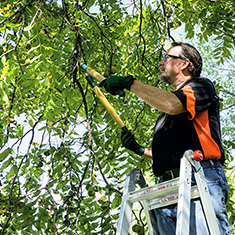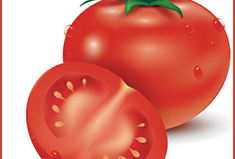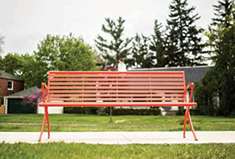Help Mother Nature by Helping Trees Thrive
By Lisa Howard
STATELY OAKS, SHOWY MAGNOLIAS, PLUCKY MAPLES…EVERYONE HAS A FAVORITE TREE.
Kerry Lark, a certified arborist with a horticultural degree who has taught at MSU and various community colleges, chose gingko trees and a dawn redwood tree for his property. Really, though, he loves all trees. “I’ve been digging in the dirt my whole life,” he says. “I hate cutting down trees — I always try to save them. I want to help all trees thrive.”
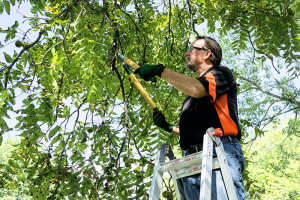 His mantra is “Right tree, right spot.” That isn’t always easy to adhere to, though, particularly if someone else put the tree there or if conditions around the tree have changed in unfavorable ways: A canopy tree that needs more sun gets shaded out, an understory tree that wasn’t meant to be in full sun suddenly is, soil conditions have become fundamentally different, and so on. Or maybe the tree has fallen victim to “weed whackeritis,” which is when people bang into the trunk of a tree with a weed whacker or lawn- mower and injure it. That kills a lot of trees, Kerry says, especially young ones. To prevent such injuries, he recommends cutting out the surrounding sod three feet out from the tree in a circle and putting down mulch — then the tree will be protected from physical damage. Although do not heap up mulch (or soil, or anything else) against the tree! That will rot the trunk.
His mantra is “Right tree, right spot.” That isn’t always easy to adhere to, though, particularly if someone else put the tree there or if conditions around the tree have changed in unfavorable ways: A canopy tree that needs more sun gets shaded out, an understory tree that wasn’t meant to be in full sun suddenly is, soil conditions have become fundamentally different, and so on. Or maybe the tree has fallen victim to “weed whackeritis,” which is when people bang into the trunk of a tree with a weed whacker or lawn- mower and injure it. That kills a lot of trees, Kerry says, especially young ones. To prevent such injuries, he recommends cutting out the surrounding sod three feet out from the tree in a circle and putting down mulch — then the tree will be protected from physical damage. Although do not heap up mulch (or soil, or anything else) against the tree! That will rot the trunk.
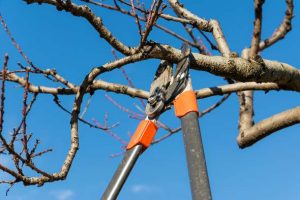
ANOTHER CONSIDERATION WHEN PLANTING A TREE IS HOW BIG WILL IT GET? And what kind of shape will it have? Trees grow. It takes a while, but eventually, an ill-placed, ill-sized tree could become a hazard and might need to be tragically cut down before its time. Having all of the same type of tree could also be problematic, particularly if said trees are prone to disease — Dutch elm disease, chestnut blight, and emerald ash borer have all wreaked havoc in Michigan. That’s why Kerry is a proponent of incorporating both native and nonnative trees in urban landscapes.
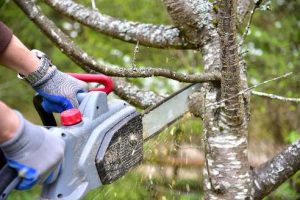 “Nonnatives are resistant to the diseases they brought with them because they co-evolved with those diseases, whereas our native species have no resistance and they’ll get wiped out,” Kerry says. On top of that, just because a tree is native doesn’t mean it will thrive in an urban / city area — those surroundings are nothing like a forest. “Cities have a lot of pollution in comparison,” Kerry points out, “plus they tend to have heavy clay soil in a lot of areas.” One example of a tough nonnative are gingko trees: They can handle city pollution very well and don’t require any chemicals or inputs to remain robust.
“Nonnatives are resistant to the diseases they brought with them because they co-evolved with those diseases, whereas our native species have no resistance and they’ll get wiped out,” Kerry says. On top of that, just because a tree is native doesn’t mean it will thrive in an urban / city area — those surroundings are nothing like a forest. “Cities have a lot of pollution in comparison,” Kerry points out, “plus they tend to have heavy clay soil in a lot of areas.” One example of a tough nonnative are gingko trees: They can handle city pollution very well and don’t require any chemicals or inputs to remain robust.
The inherent strength of a tree matters, too. Silver maples are notorious for not having a good structure (they tend to split themselves apart), mulberries are weak-wooded and fall apart in storms (but their admittedly messy fruits are delicious!), and trees like redbuds and American dogwoods are barely hardy in Michigan (you won’t see them north of here). On the plus side, judiciously pruning trees during the dormant months of November through March can help them have a stronger, better-shaped structure. What nonprofessionals call “suckers” and arborists call “epicormic shoots” take energy away from the rest of the tree, including the leaves and flowers, so it’s usually best to trim those.
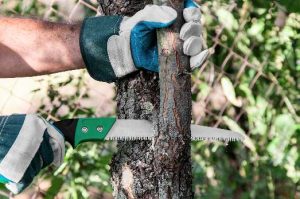 It’s also sometimes possible to enrich the soil with amendments to help a struggling tree thrive. But really, the best way to help trees is to remember Kerry’s cardinal rule: “Right tree, right spot.” Thinking of planting a tree? To research your options, search for “MSU smart tree tips.”
It’s also sometimes possible to enrich the soil with amendments to help a struggling tree thrive. But really, the best way to help trees is to remember Kerry’s cardinal rule: “Right tree, right spot.” Thinking of planting a tree? To research your options, search for “MSU smart tree tips.”
Kerry Lark can be reached at 810-499-0953.

